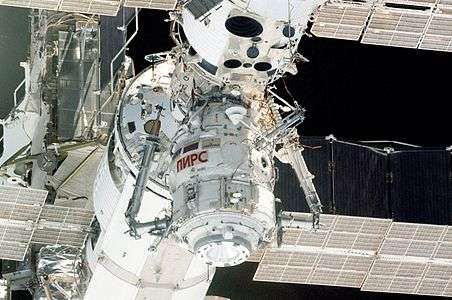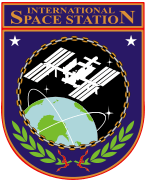Pirs (ISS module)
|
The SO-1 module docked to the International Space Station | |
| Station statistics | |
|---|---|
| Part of: | International Space Station |
| Launch date: | September 14, 2001 |
| Launch vehicle: | Soyuz-U/Progress M-SO1 |
| Docked: | September 16, 2001 |
| Undocked: | TBA 2017 (planned) |
| Reentry: | TBA 2017 (planned) |
| Mass: | 3,580 kg |
| Length: | 4.91 m |
| Diameter: | 2.55 m |
| Living volume: | 13 cubic metres (460 cu ft) |
Pirs (Russian: Пирс, meaning "pier") -- also called "Stykovochny Otsek 1" or "SO-1" (Russian: Стыковочный отсек, "docking module", or DC-1 (docking compartment) -- is one of the two Russian docking compartments originally planned for the ISS. Pirs was launched in August 2001. It provides the ISS with one docking port for Soyuz and Progress spacecraft, and allows egress and ingress for spacewalks by cosmonauts using Russian Orlan space suits.
A second docking compartment, "Stykovochniy Otsek 2" or SO-2, was initially planned with the same design. However, when the Russian segment of the ISS was redesigned in 2001, the new design no longer included the SO-2, and its construction was canceled.[1] After another change of plans the SO-2 module finally evolved into the Poisk module, which was added to the ISS in 2009.
Pirs is scheduled to be detached from the ISS in 2017 and to be deorbited, to make room for the Russian Multipurpose Laboratory Module Nauka.
Design and construction
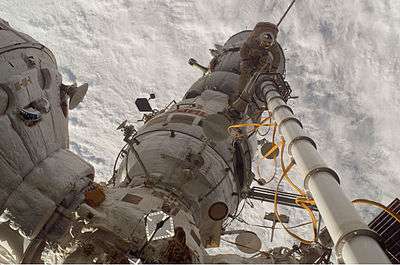
The Docking Compartment has two primary functions: Provide a docking port and serve as an airlock.
The docking port can accommodate one Soyuz-TMA or one Progress-M spacecraft. Visiting spacecraft can deliver people and cargo to and from to the space station. In addition, the Docking Compartment can transport fuel from the fuel tanks of a docked Progress resupply vehicle to either the Zvezda Service Module Integrated Propulsion System or the Zarya Functional Cargo Block. It can also transfer propellant from Zvezda and Zarya to the propulsion system of docked vehicles—Soyuz and Progress.
The two airlocks are used for spacewalks by cosmonauts wearing Russian Orlan-M spacesuits.
The Pirs docking compartment was manufactured by RKK Energia. The Docking Compartment is similar to the Mir Docking Module used on the Mir space station. The docking compartment's planned lifetime as part of the station was five years.
Launch in 2001
Pirs was launched on September 14, 2001, as ISS Assembly Mission 4R, on a Russian Soyuz-U rocket, using a modified Progress spacecraft, Progress M-SO1, as an upper stage.
The 3,580-kilogram Pirs Docking Compartment is attached to the nadir (bottom, Earth-facing) port of the Zvezda service module. It docked to the International Space Station on September 16, 2001, and was configured during three spacewalks by the Expedition 3 crew. Two Strela cargo cranes were later added by the STS-96 and STS-101 missions, carried up on Integrated Cargo Carriers and installed during EVAs.
Future
Pirs was originally scheduled to be detached from the nadir (bottom) port of the Zvezda module in 2014[2] to make room for the Russian Multipurpose Laboratory Module Nauka.[3] This has been delayed to 2017 due to a series of launch failures with the Proton rocket leading to delays in the launch of Nauka.[4] When that happens, Pirs could become the first permanent ISS module to be decommissioned, and would be destroyed during atmospheric re-entry.
Airlock specifications
- Length: 4.91 metres (16.1 ft)
- Diameter: 2.55 metres (8 ft 4 in)
- Weight: 3,580 kilograms (7,890 lb)
- Volume: 13 cubic metres (460 cu ft)
Gallery
Outside
- Hover over each photo to view label detail
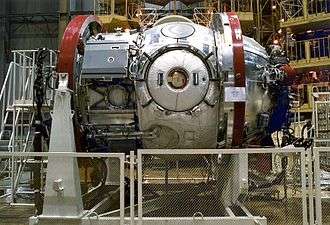 Pirs under construction at Energia in Moscow.
Pirs under construction at Energia in Moscow.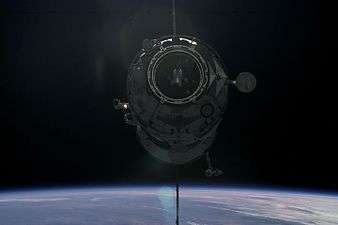 Progress M-SO1 with the Pirs module seen from the International Space Station during docking.
Progress M-SO1 with the Pirs module seen from the International Space Station during docking.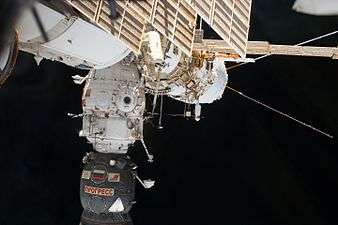 Cosmonaut Alexander Misurkin (top center), participates in a session of extravehicular activity (EVA) near Pirs module.
Cosmonaut Alexander Misurkin (top center), participates in a session of extravehicular activity (EVA) near Pirs module.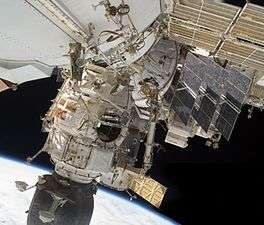 Image of the Pirs taken during a March 2009 EVA
Image of the Pirs taken during a March 2009 EVA
Inside
 Cosmonaut Oleg Kotov works with a Russian Orlan spacesuit in the Pirs Docking Compartment
Cosmonaut Oleg Kotov works with a Russian Orlan spacesuit in the Pirs Docking Compartment Gennady Padalka (left) and astronaut Mike Fincke pose with their Orlan spacesuits
Gennady Padalka (left) and astronaut Mike Fincke pose with their Orlan spacesuits Oleg Kononenko is pictured near a hatch in the Pirs Docking Compartment
Oleg Kononenko is pictured near a hatch in the Pirs Docking Compartment Cosmonaut Gennady Padalka, Expedition 20 commander, is pictured inside Pirs
Cosmonaut Gennady Padalka, Expedition 20 commander, is pictured inside Pirs
See also
- Poisk (ISS module) (similar module)
References
- ↑ Anatoly Zak. "Docking Compartment of the Russian segment of the ISS".
- ↑ http://en.ria.ru/russia/20130419/180737723.html
- ↑ "Consolidated Launch Manifest". nasa.gov. 2011. Retrieved March 6, 2011.
- ↑ http://www.russianspaceweb.com/iss_fgb2.html
External links
| Wikimedia Commons has media related to Pirs. |
- "Pirs Docking Compartment". NASA.
